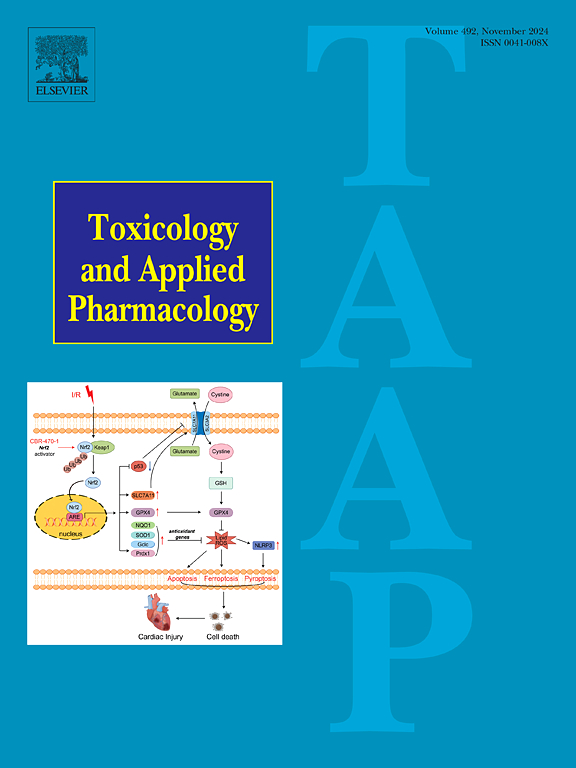脊髓麻醉对胸椎切口大鼠心肌损伤、超微结构及细胞机制的影响
IF 3.3
3区 医学
Q2 PHARMACOLOGY & PHARMACY
引用次数: 0
摘要
目的探讨手术对心脏损伤的影响和心脏显微超微结构的改变,以及脊髓麻醉可能的保护细胞机制。方法将雄性Sprague-Dawley大鼠随机分为4组:对照组(正常大鼠)、假手术组(注射脊髓生理盐水)、手术组(注射脊髓生理盐水后手术)和布比卡因组(注射脊髓布比卡因0.5%,50 μL,手术后)和布比卡因组(注射脊髓布比卡因0.5%,50 μL,手术后)。检测大鼠血清和心脏肌钙蛋白I、NT-proBNP、电镜、儿茶酚胺、氧化应激和内质网应激标志物、细胞凋亡和自噬。结果手术后,心脏出现损伤迹象,组织肌钙蛋白I降低,NT-proBNP水平升高。电镜显示线粒体肿胀、紊乱、胞质空泡。血清肾上腺素水平及β1和β2肾上腺素能受体表达升高。血清硝酸盐和亚硝酸盐水平(氧化应激标志物)以及内质网络应激指标GRP78和自噬指标LC3和LAMP-1升高,心肌细胞凋亡增加。使用脊髓布比卡因可减轻这些影响。结论手术可引起心肌超微结构和细胞损伤,增加交感神经活性、氧化应激和内质网应激,导致心肌细胞自噬和凋亡。脊髓麻醉可以保护心脏免受这些伤害。本文章由计算机程序翻译,如有差异,请以英文原文为准。

Impact of spinal anesthesia on myocardial damage, ultrastructure and cellular mechanisms in rats undergoing thoracic incision surgery
Aims
This study aimed to investigate the impact of surgery on cardiac injury and microscopic ultrastructural changes in the heart, as well as the potential protective cellular mechanisms of spinal anesthesia.
Methods
Male Sprague-Dawley rats were randomly assigned to four groups: Control (regular rats), Sham (received spinal saline injection), Surgery (received spinal saline followed by surgery) and Bupivacaine (received spinal bupivacaine 0.5 %, 50 μL followed by surgery), and Bupivacaine (received spinal bupivacaine 0.5 %, 50 μL followed by surgery). The serum and hearts of the rats were assessed for troponin I, NT-proBNP, electron microscopy, catecholamines, markers of oxidative stress and endoplasmic reticulum stress, as well as apoptosis and autophagy.
Results
After surgery, the hearts showed signs of injury, with decreased tissue troponin I and elevated NT-proBNP levels. Electron microscopy revealed mitochondrial swelling, disarrangement and cytosolic vacuoles. Serum epinephrine levels and expression of β1 and β2 adrenergic receptors were elevated. Serum nitrate and nitrite levels (markers of oxidative stress), along with the ER stress indicator GRP78 and autophagy indicators LC3 and LAMP-1, were heightened, and cardiomyocyte apoptosis increased. These effects can be mitigated with the use of spinal bupivacaine.
Conclusions
Surgery can cause ultrastructural and cellular damage, elevate sympathetic activity, oxidative stress, and endoplasmic reticulum stress, leading to autophagy and cardiomyocyte apoptosis. Spinal anesthesia can protect the heart from these injuries.
求助全文
通过发布文献求助,成功后即可免费获取论文全文。
去求助
来源期刊
CiteScore
6.80
自引率
2.60%
发文量
309
审稿时长
32 days
期刊介绍:
Toxicology and Applied Pharmacology publishes original scientific research of relevance to animals or humans pertaining to the action of chemicals, drugs, or chemically-defined natural products.
Regular articles address mechanistic approaches to physiological, pharmacologic, biochemical, cellular, or molecular understanding of toxicologic/pathologic lesions and to methods used to describe these responses. Safety Science articles address outstanding state-of-the-art preclinical and human translational characterization of drug and chemical safety employing cutting-edge science. Highly significant Regulatory Safety Science articles will also be considered in this category. Papers concerned with alternatives to the use of experimental animals are encouraged.
Short articles report on high impact studies of broad interest to readers of TAAP that would benefit from rapid publication. These articles should contain no more than a combined total of four figures and tables. Authors should include in their cover letter the justification for consideration of their manuscript as a short article.

 求助内容:
求助内容: 应助结果提醒方式:
应助结果提醒方式:


